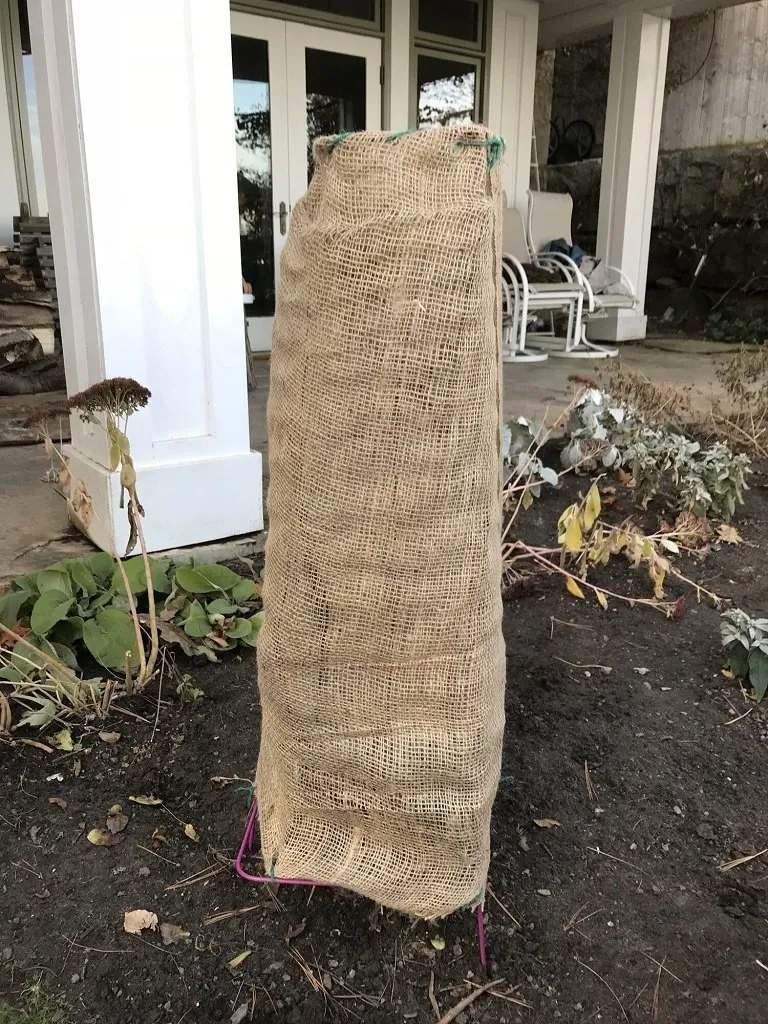Introduction
Winter can be a challenging season for gardeners, as frost, cold winds, and freezing temperatures pose a serious threat to the health of plants. Without proper protection, many types of plants—especially perennials, shrubs, and young trees—can suffer from frostbite, drying, and even die due to harsh winter conditions. This is why winterizing your garden is essential to ensure that your plants survive and thrive when spring returns.
One of the most effective and eco-friendly methods for protecting plants during the winter is using burlap. Burlap, a natural and breathable fabric, acts as a shield, offering both insulation and air circulation. In this guide, we will explore how to use burlap for winterizing plants, the benefits of this material, and step-by-step instructions to help you safeguard your garden. Whether you’re dealing with freezing winds or sudden temperature drops, burlap can be the perfect solution for winter plant protection.

Why Winterizing Plants is Essential
As temperatures drop and frost becomes more frequent, certain plants are at risk of damage. For example, tender perennials, young saplings, evergreens, and some varieties of shrubs are especially vulnerable to winter’s wrath. Frost can cause plant tissues to freeze, leading to frostbite, which damages leaves and stems. Cold winds can dry out plants, leaving them dehydrated and unable to recover once the warmer weather returns. Additionally, alternating periods of thawing and freezing can wreak havoc on root systems, leading to plant death.
Winterizing plants helps protect them from these dangers. By taking preventive measures, gardeners can ensure their plants retain enough moisture, warmth, and overall vitality to survive the colder months. Burlap offers an ideal solution for winterizing plants because it creates a protective barrier without suffocating the plants, making it a reliable option for both experienced and novice gardeners.
Benefits of Using Burlap for Winterizing Plants
There are several benefits to using burlap for winterizing plants, making it one of the most popular materials among gardeners for this purpose:
- Breathability: Unlike plastic or synthetic materials, burlap allows air to circulate while still providing a protective barrier. This is crucial because plants need to breathe, even during the winter. Burlap helps prevent moisture from getting trapped, which could lead to mold or rot.
- Insulation: Burlap acts as a natural insulator, keeping cold winds from drying out your plants and protecting them from extreme temperature fluctuations. Its thick weave can block frost while maintaining enough warmth around the plant’s structure.
- Eco-friendly: Burlap is biodegradable and reusable, making it an environmentally sustainable option. After the winter season, you can reuse the burlap or compost it, which contributes to reducing waste in the garden.
- Cost-effective: Burlap is an affordable option compared to many other materials, especially when purchased in bulk. This makes it accessible for gardeners with large areas to cover.
Given these benefits, burlap has become a trusted method for protecting plants, especially for larger shrubs, sensitive perennials, and evergreens, which often face the brunt of winter weather.
Step-by-Step Guide to Winterizing Plants with Burlap
Step 1: Choose the Right Burlap
Before you start winterizing your plants, make sure to choose the appropriate burlap material. Burlap is available in different thicknesses, so select a weave that is durable enough to provide protection but not so tight that it blocks airflow. You can find burlap at most garden centers or online, often sold by the yard or in pre-cut sheets.
Step 2: Preparing the Plants
Preparation is key to ensuring successful winterization. Before wrapping your plants in burlap:
- Prune the plants: Remove any dead or weak branches to reduce the chance of disease or pest infestation during the winter.
- Water thoroughly: Water your plants well before the first frost. Proper hydration will help them withstand the cold and prevent winter dehydration.
Step 3: Wrapping the Plants
Now that your plants are ready, it’s time to wrap them in burlap. Follow these steps based on the type of plant:
- For Shrubs and Small Trees:
- Create a framework around the plant using wooden stakes. This will prevent the burlap from touching the plant directly, reducing the risk of breakage or abrasion from wind.
- Drape the burlap over the stakes and around the plant, ensuring that the entire structure is covered. Use twine or garden ties to secure the burlap in place.
- Make sure the burlap is snug but not too tight, allowing for some airflow.
- For Perennials:
- For smaller plants, simply wrap the burlap around the plant itself.
- Secure the fabric with twine, but ensure you don’t bind the plant too tightly to avoid crushing or damaging it.
Step 4: Maintaining the Burlap Wrap
Throughout the winter, periodically check your plants and burlap coverings. Ensure the burlap remains secure and adjust it if it shifts due to wind or snow. Make sure the stakes remain stable, and replace any damaged burlap if necessary.
Additional Tips for Winter Plant Protection
In addition to using burlap, you can take other steps to ensure your plants are well-protected throughout the winter months:
- Mulch: Apply a thick layer of mulch around the base of your plants to help insulate the roots and retain moisture in the soil. Mulch also acts as a barrier against frost.
- Stakes: Use stakes to hold the burlap away from delicate branches, especially for shrubs and evergreens.
- Remove Burlap in Spring: As the weather starts to warm, be sure to remove the burlap at the right time. Leaving it on too long could cause your plants to overheat or prevent new growth.
Conclusion: Start Winterizing Your Plants Today
Using burlap for winterizing plants is an effective, affordable, and environmentally friendly way to protect your garden from harsh winter conditions. By taking the time to wrap your plants in burlap, you ensure they stay insulated, ventilated, and safe from frostbite, wind damage, and dehydration. Now that you have a complete guide, it’s time to start preparing your garden for the colder months. Don’t wait until the first frost—begin winterizing your plants today to ensure they thrive next spring!






